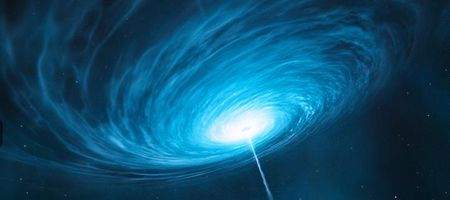Scientists at NASA have discovered a new constant that links different sizes of black holes.

A black hole jet is the stream of gamma radiation often emitted from the ‘event horizon’, the innermost edge and point of no return, of a black hole. When gas gets sucked into the black hole, some of the material becomes accelerated and races outward as a pair of jets flowing in opposite directions. Jets are seen in black holes of many different sizes; from the modest-sized, to the behemoth holes that power the centres of galaxies.
The team of scientists at NASA examined 54 gamma-ray bursts (GRBs) from the smaller black holes and compared them to 234 blazars and quasars, the galactic-scale equivalent of GRBs emitted from supermassive black holes. The team found the same set of physical rules governed the size of these jets, regardless of the black hole size.
The discovery was made using NASA’s Swift satellite and Fermi Gamma-ray Space Telescope.
“What we’re seeing is that once any black hole produces a jet, the same fixed fraction of energy generates the gamma-ray light we observe with Fermi and Swift,” says lead researcher Rodrigo Nemmen.
“It’s a bit like a poor man and a billionaire spending the same percentage of their incomes on their heating bills,” adds team member Markos Georganopoulos, an associate professor of physics at the University of Maryland, Baltimore County.
The finding simplifies our understanding of black holes as it means that they are governed by the same set of rules, whatever their size. Independent of mass, age, or the jet’s brightness and power, a similar fraction of the hole’s energy, between 3 and 15 percent, is emitted. The so-called ‘symmetry’ between different sizes of black holes could help astronomers to understand the universal laws that underpin black holes.
“Here we have a situation where the mechanism that launches material from a black hole either has to be very similar on both ends of the mass scale — from a few to a billion solar masses, or we need different mechanisms that manage to produce very similar efficiencies,” says another co-author Eileen Meyer.
The team hope to extend the research to other black-hole-powered events that launch jets, such as the tidal disruption of stars by supermassive black holes.






